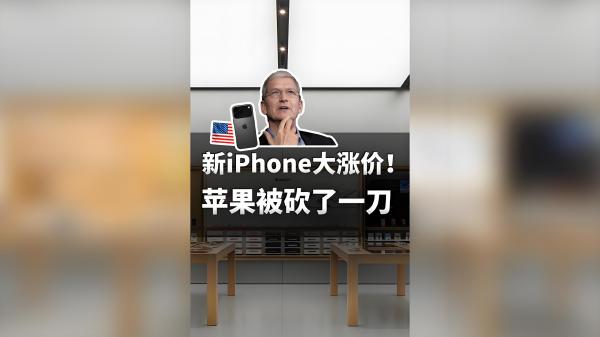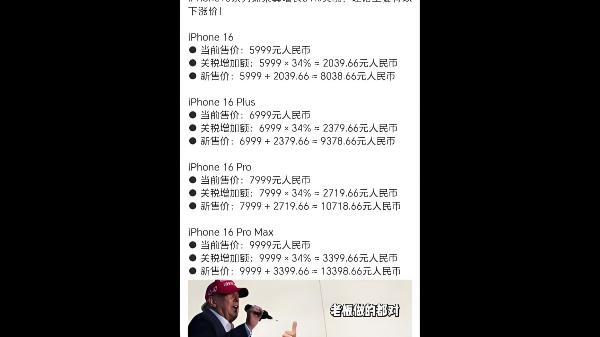Apple iPhone Prices Skyrocket: Navigating Tariffs, Supply Chain Turbulence, and Market Maneuvers
![]() 04/09 2025
04/09 2025
![]() 396
396
The internet has buzzed with discussions about the surge in Apple iPhone prices. From the ripple effects of supply chain costs to the impact of tariff policies, and from the escalation of high-end model prices to consumer backlash, this article delves into the intricate logic behind this pricing storm. By synthesizing data from multiple sources, we provide a comprehensive analysis of the inevitability, variations in magnitude, and market implications of the iPhone price increase.

I. The Catalysts Behind the Price Surge: Tariff Policies and Supply Chain Strains
Tariff Tsunami: The US government's imposition of a 54% "reciprocal tariff" on China has directly impacted Apple's supply chain. Morgan Stanley estimates that this tariff alone will add $8.5 billion annually to Apple's costs. With 90% of iPhones assembled in China, these tariff pressures are unavoidable.
Cost Transmission: Apple's commitment to maintaining a 38% profit margin necessitates passing these costs on to consumers. Analysts predict that the iPhone 17 series' starting price may exceed 8000 yuan, with the premium model reaching 20,000 yuan, marking a 43% increase.
II. Strategic Pricing: Differential Analysis Across Models
Standard vs. Pro Versions:
Strategy Insight:
Standard Version: A modest price hike to gauge market response, leveraging the "value-for-money" appeal to attract budget-conscious consumers.
Pro/Pro Max: A substantial price increase to reinforce the premium positioning, targeting users with low price sensitivity and little direct competition from Android devices.
III. Market Responses: Ripple Effects on Consumers, Competitors, and the Ecosystem
Consumer Perspective:
Short-Term Reaction: A "panic buying" trend emerged on e-commerce platforms, with the iPhone 16 Pro Max selling out even at a subsidized price of 9969 yuan.
Long-Term Trend: Over 60% of potential buyers stated they "cannot accept an iPhone priced above $2000," hinting at a growth opportunity for high-end Android models like the Samsung S25 and Huawei Pura X.
Competitor Landscape:
Android Camp: Accelerating innovation in camera, display, and fast charging technologies to narrow the experience gap with Apple.
Operators' Role: May introduce higher subsidy packages to lower the entry barrier for phone purchases.
Supply Chain Stress:
Chinese Suppliers: Foxconn and Luxshare Precision face pricing pressures, with potential order shifts to India and Vietnam.
Apple Ecosystem: Accessories such as AirPods and iPads may also witness price hikes, affecting the overall ecosystem's competitiveness.

IV. Apple's Countermeasures and Future Trajectory: The Strategic Gambit Behind the Price Hike
Short-Term Tactics:
Differentiated Pricing: Reducing perceived costs through operator subsidies and trade-in programs.
Technological Premium: Enhancing features like AI photography and satellite communication to boost product value.
Political Maneuvering: Cook's team is again lobbying for tariff exemptions, though success is uncertain.
Long-Term Risks:
Market Share Erosion: A price hike exceeding 10% could diminish Apple's competitiveness in the Chinese market (IDC predicts a mere 3% sales increase for iPhones in 2025).
Supply Chain Realignment: Accelerating production shifts to India and Vietnam, but the Chinese supply chain's efficiency will be hard to replicate in the short term.
V. Conclusion: Is Apple's Price Hike a Crisis or an Opportunity?
Apple's iPhone price hike is both a reactive measure to tariff policies and supply chain pressures and a strategic move to fortify its premium positioning. While it may cause short-term market discomfort, it could propel the industry towards a "technology premium" model in the long run. For consumers, if the price hike is unacceptable, high-end Android devices may emerge as a more viable option. For Apple, the outcome of this pricing gamble will directly shape its market standing over the next five years.

Interactive Topic: Do you believe that after the price hike of Apple iPhones, high-end Android devices can capitalize on the opportunity to regain market share? Share your thoughts in the comments!








